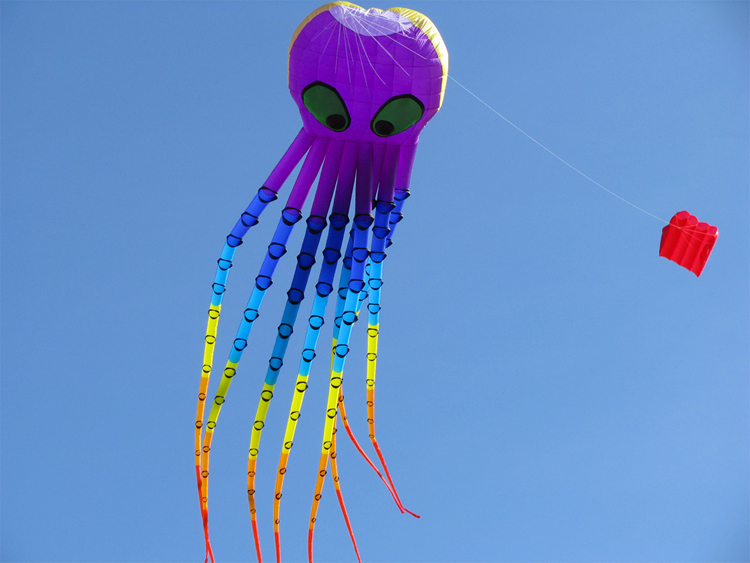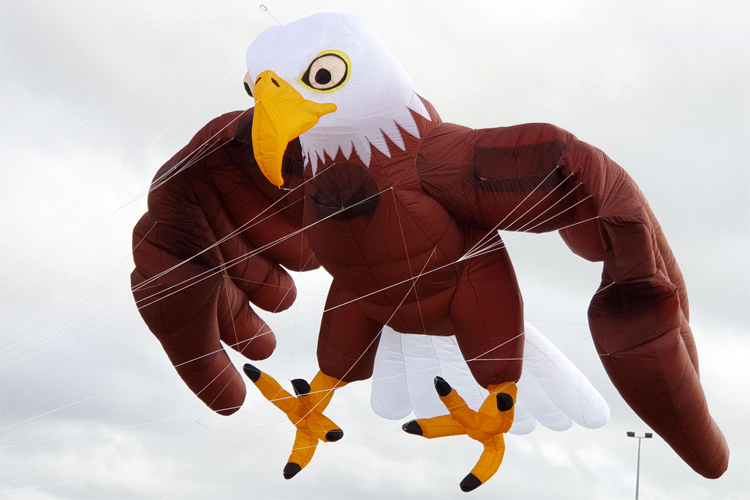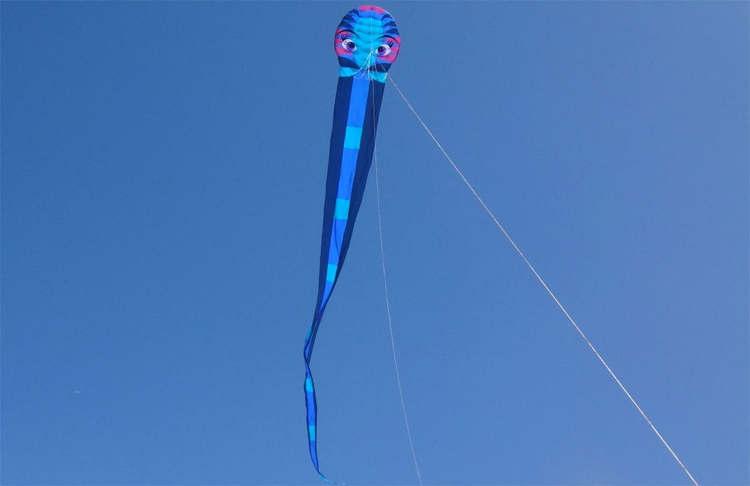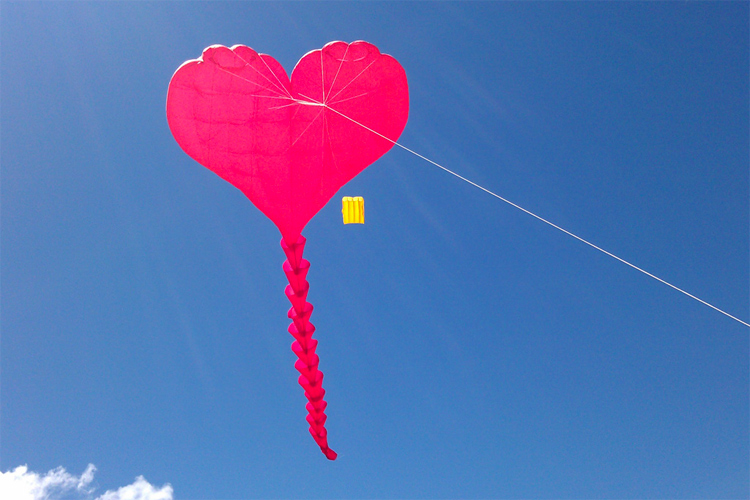The founder of Peter Lynn Kites is on a mission to establish a new single-line, single-skin kite genre. Here's what he has been doing to make it a reality.
After seven years, approaching 200 prototypes, and quite a few thousand hours of stuffing around, what do I know for sure, what am I unsure about, and what can't I understand at all?
I'm Sure That...
1. Single skins kites have a disadvantage for theme kite flying, the mainstay of kite events. Why? They have much more pull than ram air inflated kites of the same size.
An advantage is that they are twice as large as ram air kites for their weight.
Another advantage is that they are uniquely suited for the fitting of de-power lines - light secondary lines that collapse the kite when pulled in to facilitate taking down and as a safety release in case of emergency.
A 6-meter x 60-meter Serpent flying at 150 meters altitude and pulling more than 400 kilogram-meters can now be collapsed in seconds with less than five kilogram-meters pull on the secondary line.
2. The "diving over" - the tendency to randomly dive off unrecoverably to one side or the other in strong winds - that plagues Boomers and 1Skins is caused by wind-induced indentations of their leading edges.
After more than 100 prototypes, extensive testing, and elimination of other causes, I'm sure about this.
Indentation occurs because their leading edge is supported by ribs rather than directly by bridles.
When the leading edge gets pushed in by a wind gust, it remains distorted until there is enough pressure behind the leading edge to push it out again, which often doesn't happen in time to prevent a crash.
Dams, reducing the leading-edge depth, fitting stiffeners, and very careful tuning are mitigations.

3. Bridle-supported, curved leading edges like those used for the single skin Octopus, Serpent, and Keel-less pilots can resist leading-edge distortion to any wind speed yet experienced.
With automatic let-out of their leading edges in response to increasing wind speed (using total kite pull as a proxy) and aeolian rear bridles (that pull in the kite's trailing edge in strong winds), they can achieve a wind range without manual adjustment of 10 km/h to more than 100 km/h (subject to the kite's inherent stability of course).
With manual adjustment, this range can be extended down to 7 km/h, but with a significant loss of top end.
4. The annoying way that Serpent-style single-line kites "fall off" to one side or the other in very light winds (below 10 km/h) is a function of how their tails are attached to their heads and nothing else.
They fly straight until the wind drops, then go off to one side, draping themselves across every other kite on the field.
All sizes do this.
Octopus variants do as well, though to a lesser extent.
Large framed-head Serpent kites behave this way, too, as do other kite styles with tails that are large or long in comparison to their head size and attached in ways that prevent the heads from rotating independently.
To check, I tried a two-meter wide Serpent head with ties to attach various tail types.
Sure enough, this head with a Serpent tail attached full width falls off when the wind drops, as it does, to a lesser extent, with Octopus tentacles.
With the Serpent tail attached only in the center, it stays straight.
The problem is, therefore, one of graphics, not function. Jim Martin suggests a frying pan and fried egg head with the handle as the tail - this would fly perfectly.
I'm Sure Enough That...
For flat-skin SS kites, and when keels aren't used, all bridles except those to the leading edge should be the same length or very nearly.
This is because single-skin fabric surfaces are not able to resist compressive loads at all, and equal-length bridles are the minimum requirement for their support.
Spanwise, central bridles can be longer than those further out to provide some spanwise tension in the skin, but there is rarely any necessity or advantage in this.
Chordwise compression (accordioning) can be reduced by using chordwise camber, which is more than the "arc of a circle" form that equal-length bridles provide.
However, this makes single-line kites more inclined to leading-edge collapse and stalling.
Equal lengths seem best at this stage, with perhaps some minor extra length near the trailing edge to assist light wind flying.

I'm Not Sure About...
Scale. Large-framed kites weigh more per area than small ones because their structures need to be proportionally heavier to provide enough strength and rigidity.
This is why small-framed kites fly in lighter winds and why very large kites are all currently of the ram-air type.
No framed kites larger than about 200 square meters have ever flown successfully, and these weighed tonnes, whereas the current world's largest kites - 1,250 square meters - are ram-air and weigh less than 300 kilograms.
Ram air kites are not free of scale effects because the volume of air contained within them scales with dimension cubed, whereas area scales with the square.
Although air doesn't have weight in this context, it has mass - 1.23 kilograms/cubic meter - and this affects stability.
Mega kites now use thru cords instead of ribs like the large Dutch kite built in the 1980s had.
Thru cords allow kites such as Mega Flags and Rays to rotate without pulling all their internal air mass around with them, and this has enabled larger kites to fly satisfactorily.
I expected that single-skin kites would be free of scale effects because they have no frames and no internal air masses, but this understanding was wrong.
Two-meter x 20-meter SS Serpents are volatile and unstable (figure-eighting progressing to loops) from around 15 km/h wind speed.
Three-meter x 30-meter Serpents get to 25 km/h, but 6-meter x 60-meter Serpents have no upper wind limit that I've yet found.
Single-skin Octopus kites show a similar trend.
The cause of this can only be the mass of air, especially vortices, that the kite drags around with it.
Attached flow, like internal air masses for ram air kites, scales with the cube of dimension, while for a single skin kite, area, weight, and all aerodynamic forces scale with the square of dimension.
I am very surprised that this effect is significant, but evidence from many tests doesn't easily admit to any other explanation.
I'm Annoyed About...
The tentacles on single-skin Octopus kites tangle to an impossible extent unless they are linked together laterally at intervals with cords.
These links also provide the extra drag that smaller versions require for stability.
A six-meter head Octopus would probably be stable without cross-links and hold the tentacles flat, which also improves visuals.
Unfortunately, links are a menace (snagging on everything) to other kites, trees, fences, people, and especially children.
This makes single-skin Octopuses unsuitable for most public flying, which is very bloody annoying, seeing as they fly so well and look great.

I Don't Understand at All...
To my considerable surprise, I've found that single-skin Serpent-style heads, in at least the two-meter to six-meter range, will fly without any tail at all, though they are more reliable with a light ribbon tail attached to the trailing edge center.
Even more surprising, the same head with a Serpent-style tail or unlinked Octopus tentacles is volatile and unstable in smaller sizes.
If there's one lesson every kite flier learns early on, it's that adding more tail reduces volatile instability.
That tails can cause volatile instability is outside any previous experience I can remember.
It seems to have something to do with how the tail is attached. Full-width attachment causes instability; single-point attachment doesn't.
However this doesn't answer why linked Octopus tentacles are stable while unlinked ones aren't.
Perhaps it has to do with how vortices leave the kite's trailing edge, which would be affected by not connecting the tail across the full width or some feedback effect between aerodynamic and weight forces.
I don't know.
To date, I've mainly only developed single-skin, single-line kites with semi-circular leading edges and straight trailing edges.
These fly well as Pilots, Serpents, Octopuses, and other themes that fit this shape.
Working on variants (by size, bridling, and tails) of this shape has been a good way to get a better understanding of the many confusing variables involved.
To get more development time, I'm also limiting overseas kite event attendance in favor of flying at a large open area close to where I live that I can drive onto with all my gear and kites whenever the wind is what I need it to be.
I'm sure my fellow kite fliers will sorely miss being taken out while I'm learning to tame these things, but for progress, a price must be paid!
I'm on a mission.
Words by Peter Lynn | Founder of Peter Lynn Kites
